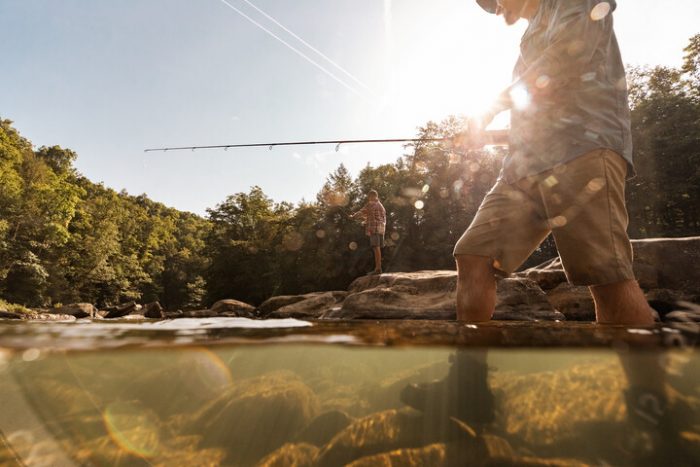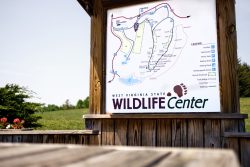Seventy-four species of mammals are currently found in the Mountain State. Some are easily recognizable, such as the white-tailed deer or black bear (West Virginia’s official state animal), but others are more secretive such as the northern flying squirrel, only showing themselves at night or restricting their presence to remote and unique habitats.
Species of Mammals
Of the 74 species in West Virginia, 67 are native and seven are non-native. Currently, three formerly occurring species of mammal no longer exist in West Virginia: the bison, mountain lion, and gray wolf. The last recorded bison in West Virginia was killed near Valley Head in Randolph County back in 1825. Bounties were paid on wolves in West Virginia through the late 1800’s with the last recorded wolf killed in 1900. Recently, due to the lack of physical evidence of occurrence, the US Fish and Wildlife Service now considers the mountain lion extinct in West Virginia. The beaver, fisher and river otter were also eradicated in the past, but were reintroduced in the 1930’s, and 1985, respectively. The fisher was introduced in 1969. Elk were eradicated from the state by 1890 with reports of animals near the headwaters of the Tygart and Greenbrier rivers as late as 1875. Reintroduction of elk into southwestern West Virginia was initiated in 2016. Wild boars were introduced into the state in 1971. Today a population of wild boar exists in Boone, Logan, Raleigh and Wyoming counties.
Diversity of Species
The most species diverse group of mammals in the state is the rodents, with 26 species contained within 5 different families. Squirrels, beaver, jumping mice, mice, voles, wood rats, muskrat and rats are all examples of types of rodents found in the state. These rodents are an important part of the landscape in West Virginia, not only as a dispersal method for seeds of plants and trees, but also being a food source for other predatory species. Most of the predatory animals such as birds (warm-blooded vertebrates) and snakes (reptiles) in the state are directly dependent on our rodents as a large portion of their diet.
The second most diverse group of mammals in the state is the carnivores. This group contains seventeen species including weasels, skunks, black bear and raccoon. The weasel group includes three species of weasel (long-tailed, short-tailed, least), mink, fisher, and river otter. West Virginia also has two species of skunk, the eastern spotted skunk and the striped skunk.
The next most diverse group in the state is the bats. West Virginia has 14 species of bats, three of which are currently listed as endangered: Virginia big-eared bat, Indiana bat and gray bat), and one listed as threatened (northern long-eared bat). All species of bats in the state feed exclusively on insects during nighttime hours in the summer, with most of them spending the day resting and raising their young within rock crevices, under loose bark trees, or occasionally within man-made structures. One species, the Virginia big-eared bat, is the only bat to use caves year-round, for both winter hibernation and as a summer roost where it raises its young. All species of bats in WV either hibernate or migrate during the winter when their insect prey is not available. The species that hibernate in West Virginia typically will spend their winters dormant in a cave, rock cliff, or mine, living off stored fat until spring when their insect prey become available again. Although less common to occur, some species such as the big brown bat and little brown bat can use man-made structures as a hibernation site. Five species of WV bat: silver-haired, red, seminole, hoary and evening bat are migratory in nature, typically heading south when their local food supply disappears in the fall.
Next in diversity numbers are the shrews and moles. West Virginia is home to eight species of shrews and three species of moles. All shrews and moles in the state are insectivores, feeding almost exclusively on insect prey. The distinction of being the smallest mammal in the state rests with a species of shrew. The pygmy shrew holds this honor at a length of 2 inches and weight of about 0.14 ounce, the weight of a dime. Other species of shrew are not much larger, but the short-tailed shrew comes in as the heavyweight in West Virginia at 4 inches in total length and weighs one ounce. One shrew has the distinction of being called the West Virginia water shrew, the only semi-aquatic shrew that dives and preys on stream insects. WV has three species of moles: hairy-tailed, eastern and star nosed. Moles can be distinguished from shrews by both their large size (up to 6 inches and 2 ounces) and their enlarged front feet which aids them in tunneling underground which is fairly safe from predators and in search of their insect prey.
The ungulates, or hoofed animals, consists of four species in West Virginia. These are the white-tailed deer, elk, and boar. The white-tailed deer is easily one of the most recognizable species of mammal in the state, providing opportunities for both wildlife viewers and sportsmen. The elk is a newly reintroduced species to the state with a small population being established in southwestern West Virginia beginning in 2016.
A population of wild boar was introduced by the Wildlife Resources Section in the southwestern part of the state in the 1970’s to serve as a large game hunting opportunity at a time when no large species were present in that area.
There are two species of rabbit and one species of hare in the state. The Appalachian cottontail and the snowshoe hare are relatively limited in distribution in the state, mainly inhabiting higher elevation sites, while the eastern cottontail is more widespread. Rabbits in general prefer habitats with thick shrubby underbrush intermixed with open grassy areas. Hares prefer thick shrubby areas at high elevations where they mostly feed on shoots and buds of low growing shrubs.
The final member of our mammal community in West Virginia is the Virginia Opossum, West Virginia’s only Marsupial. The opossum can be found in almost every habitat in the state and fills the role of being the ultimate opportunist. It can live almost anywhere, and its diet consists of anything that is edible. It serves a vital role in keeping the environment clean by being willing to eat dead animals, rotting fruits and anything else it encounters.



